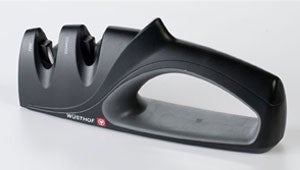That’s a new one! And a good one. Sharp tools are important, whether you’re wielding a Pulaski, a garden shovel, or a camping knife. Sharp tools work better, of course. But more importantly, they are safer. They don’t “bounce off” the target, require less force, and offer greater control.
Two-Stage Knife Sharpener
 Two-Stage Knife Sharpener
Two-Stage Knife SharpenerAnd sharpening them is quite the art. I thought I knew a fair piece about kitchen knives, but the other day I was in a kitchen supply store looking for a new sharpening steel and learned more from the guy behind the counter in five minutes than I have in five years.
But camping knives are a little bit different. I think the best solution is to invest in a good sharpening stone and start there. For instance, sells a good 250/1000 combination grit stone for $28. The 250-grit side preps the blade edge, while the 1000-grit side puts a sharp edge on it. And it’s a water stone, so no need for oil; water lubricates the stone and carries away the tiny metal bits.
I’ve also had good success with manual two-stage sharpeners, such as the 2-Stage Sharpener ($22). It has two slots you run the knife through, one with carbide steel for coarse sharpening, the other with ceramic to refine the edge.
A good hand-held steel also is useful—only don’t get a steel one. Get a ceramic steel (hah!) such as the 12″ Ceramic Knife Sharpener ($25). It will do a better job of straightening the edge. Because that’s often what accounts for “dullness”—the edge of the knife has been bent or curled. A steel straightens it out. A ceramic steel also adds just a little bit of actual sharpening to the process.


